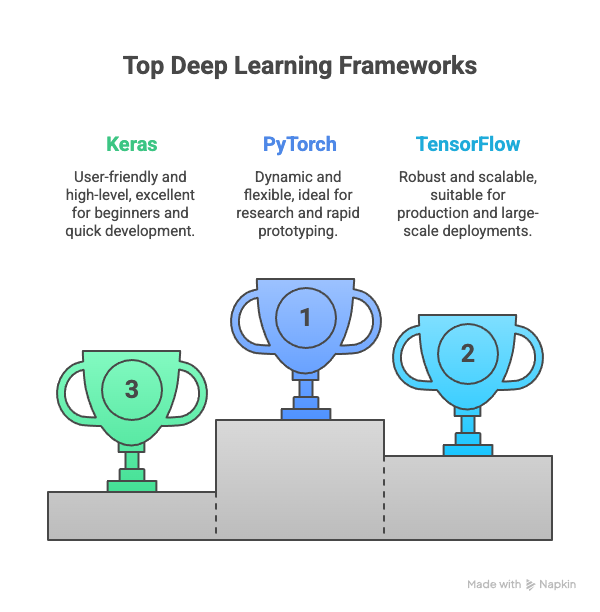PyTorch vs TensorFlow vs Keras | Which is better | Deep learning frameworks comparison
Deep learning has become a cornerstone of artificial intelligence development, powering advancements in computer vision, natural language processing, and more. Choosing the right framework is essential for both beginners and experienced developers aiming to create efficient, scalable models. Among the most popular deep learning frameworks are PyTorch, TensorFlow, and Keras. Each one offers unique advantages, suited for different use cases and levels of expertise. This article explores these three frameworks in detail, comparing their core features, usability, performance, and community support to help you decide which one may be the best fit for your deep learning projects.

Design philosophy and usability
Usability is a critical factor when selecting a deep learning framework. PyTorch is often praised for its dynamic computational graph, which allows developers to write code that runs immediately and is highly intuitive. This nature makes debugging easier and encourages experimentation, which is why many researchers prefer PyTorch, especially in academia.
TensorFlow, originally developed by Google Brain, traditionally used static computation graphs, requiring the full model graph to be defined before execution. However, with TensorFlow 2.0, eager execution was introduced, greatly improving usability and making it more user-friendly and akin to PyTorch. TensorFlow is known for its production readiness and scalability, favored by large enterprises for deploying models at scale.
Keras started as a high-level API specifically designed to work on top of backends like TensorFlow. With the integration into TensorFlow 2.x, Keras became TensorFlow’s official high-level interface, providing a simple, clean syntax that lowers the bar for beginners and accelerates prototyping. Keras abstracts away much of the complexity, making it accessible without sacrificing power.
Performance and scalability
Performance can vary significantly depending on the framework architecture and how models are deployed. TensorFlow excels at production environments, supporting distributed training and GPU/TPU acceleration with seamless integration. Its ecosystem includes TensorFlow Serving and TensorFlow Lite, enabling optimized deployment for web and mobile devices.
PyTorch has made rapid improvements in scalability and performance, especially with libraries like TorchScript and tools such as PyTorch Distributed, which enable model export and distributed training. Although it was initially seen as more research-focused, PyTorch is now actively used in production, matching many aspects of TensorFlow’s capabilities.
Keras, being an API rather than a standalone framework, inherits its performance characteristics from the backend it uses. With TensorFlow as the backend, Keras benefits from TensorFlow’s optimization and deployment tools. However, Keras’ main strength is ease of use rather than raw performance.
Community support and ecosystem
When choosing a deep learning framework, strong community support and a rich ecosystem of tools and libraries are vital. TensorFlow boasts one of the largest communities, extensive documentation, tutorials, and pre-trained models. Its ecosystem also includes specialized tools like TensorBoard for visualization and TensorFlow Hub for reusable modules.
PyTorch’s community has grown substantially, driven by enthusiastic researchers and developers who contribute cutting-edge implementations and share resources on platforms such as GitHub and forums. PyTorch Hub provides pre-trained models similarly to TensorFlow Hub, and ecosystem tools continue expanding.
Keras benefits from the widespread adoption of TensorFlow and is often the first choice for newcomers due to its straightforward API and extensive learning resources. Despite being simpler, Keras users can tap into TensorFlow’s rich ecosystem indirectly.
Comparison summary
| Feature | PyTorch | TensorFlow | Keras (TensorFlow backend) |
|---|---|---|---|
| Ease of use | High (dynamic graphs, Pythonic) | Medium-High (eager execution since 2.0) | Very high (simple API, great for beginners) |
| Performance | High (improving for production) | Very high (optimized for scale and deployment) | High (inherits TensorFlow performance) |
| Scalability | Good (distributed training supported) | Excellent (multi-platform, TPU support) | Good (depends on TensorFlow backend) |
| Community and ecosystem | Growing rapidly | Large and mature | Large (via TensorFlow) |
| Primary use cases | Research, prototyping, academic | Production, large-scale deployment | Beginners, fast prototyping |
Conclusion
Choosing between PyTorch, TensorFlow, and Keras depends largely on your project needs and background. If you prioritize research agility and ease of debugging, PyTorch stands out as a highly flexible and developer-friendly option. TensorFlow remains a powerhouse for production environments, offering scalability, advanced deployment tools, and industry-level support. Meanwhile, Keras, integrated within TensorFlow, is ideal for beginners and rapid prototyping due to its clean, simple API.
In essence, none of these frameworks is universally “better”—each has strengths tailored to specific applications. For deep learning researchers or those experimenting with innovative models, PyTorch offers an intuitive platform. For enterprises focusing on scalable, production-ready solutions, TensorFlow is often preferred. Keras provides an accessible entry point, especially for users wanting to prioritize ease of development without compromising access to TensorFlow’s robust backend. Understanding these nuances will enable you to select the best tool for your deep learning journey.
